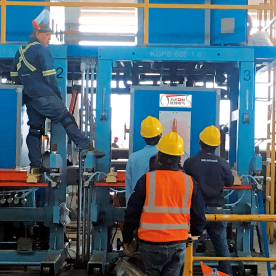[High-Speed Flying Saw Machine]Revolutionizing Manufacturing: The Impact of High-Speed Flying Saw Machines on Efficiency and Precision in Material Cutting
News 2024-7-26

Revolutionizing Manufacturing: The Impact of High-Speed Flying Saw Machines on Efficiency and Precision in Material Cutting

Revolutionizing Manufacturing: The Impact of High-Speed Flying Saw Machines on Efficiency and Precision in Material Cutting
At their core, high-speed flying saw machines are designed to provide quick and precise cuts for a wide range of materials. Unlike traditional saws, which often require the operator to halt the flow of material for cutting, high-speed flying saws can operate continuously, allowing for a seamless production process. This capability significantly enhances operational speed and efficiency, making them an invaluable asset in high-volume production environments.
One of the standout features of flying saw machines is their ability to maintain exceptional cutting accuracy even at high speeds. Typically, these machines utilize specialized blade designs and advanced motor technologies that can achieve cutting speeds of up to 1,200 feet per minute. Such precision is crucial in industries where tolerances are tight, and any deviation can lead to costly waste or rework. The drive for accuracy also ensures that the finished products meet stringent industry standards, thereby bolstering customer satisfaction.
The composition of materials that high-speed flying saw machines can process is broad. From thick steel to thin plastics, these machines are adaptable, allowing manufacturers to expand their capabilities without investing in multiple cutting systems. This versatility not only optimizes the workflow but also minimizes the need for manual labor in cutting processes, reducing labor costs and mitigating risks associated with workplace injuries.

Revolutionizing Manufacturing: The Impact of High-Speed Flying Saw Machines on Efficiency and Precision in Material Cutting
The benefits of adopting high-speed flying saw machines extend beyond mere operational efficiency. These machines can significantly reduce material waste, which is a critical cost factor in production. With traditional cutting methods, there is often a considerable amount of scrap generated due to inaccurate cuts or the need for follow-up operations. In contrast, the precision of flying saws minimizes this waste by ensuring that cuts are made correctly the first time. This means lower material costs, increased sustainability, and improved profitability for businesses.
Moreover, the implementation of high-speed flying saw machines aligns with the broader trend of automation and digitization in manufacturing. As companies strive to embrace Industry 4.0 principles, integrating advanced machinery like flying saws not only enhances their operational workflows but also positions them competitively in an increasingly digital marketplace. The insights gained from machine analytics can also contribute to predictive maintenance, reducing downtime and extending the lifespan of the equipment.
The versatility of high-speed flying saw machines has found applications across various industries. From construction to automotive manufacturing, these machines play a vital role in producing components that require precise dimensions and clean edges. For example, in the fabrication of structural steel, flying saws ensure that beams and plates are cut to specifications, streamlining the assembly process. In the automotive sector, they are used for cutting intricate parts that need to meet rigorous safety and performance standards.
In conclusion, high-speed flying saw machines represent a significant advancement in material processing technology. Their ability to deliver high-speed, precise cuts while reducing waste and labor costs makes them indispensable in the modern manufacturing landscape. As industries continue to evolve and the demand for efficiency and accuracy grows, these machines will undoubtedly play an increasingly crucial role in shaping the future of manufacturing. By embracing the potential of high-speed flying saw machines, manufacturers can enhance their competitiveness and better meet the ever-changing needs of their clients.
